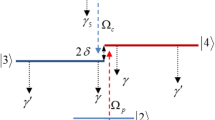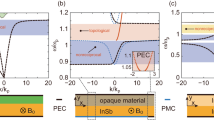Abstract
The phenomenon of extraordinary light transmission through metallic films perforated by nanohole arrays at optical frequencies was first observed a decade ago1 and initiated important further experimental and theoretical work. In view of potential applications of such structures—for example, subwavelength optics2,3, optoelectronics devices4,5, and chemical sensing6—it is important to understand the underlying physical processes in detail. Here we derive a microscopic theory of the transmission through subwavelength hole arrays, by considering the elementary processes associated with scattering of surface-plasmon-polariton (SPP) modes by individual one-dimensional chains of subwavelength holes. Using a SPP coupled-mode model that coherently gathers these elementary processes, we derive analytical expressions for all the transmission spectrum characteristics—such as the resonance wavelength, the peak transmission and the anti-resonance. Further comparisons of the model predictions with fully vectorial computational results allow us quantitatively to check the model accuracy and to discuss the respective impacts of SPP modes and of other electromagnetic fields on producing the extraordinary transmission of light. The model greatly expands our understanding of the phenomenon and may affect further engineering of nanoplasmonic devices.
This is a preview of subscription content, access via your institution
Access options
Subscribe to this journal
Receive 51 print issues and online access
$199.00 per year
only $3.90 per issue
Buy this article
- Purchase on Springer Link
- Instant access to full article PDF
Prices may be subject to local taxes which are calculated during checkout



Similar content being viewed by others
References
Ebbesen, T. W., Lezec, H. J., Ghaemi, H. F., Thio, T. & Wolff, P. A. Extraordinary optical transmission through sub-wavelength hole arrays. Nature 391, 667–669 (1998)
Alkaisi, M. M., Blaikie, R. J., McNab, S. J., Cheung, R. & Cumming, D. R. S. Sub-diffraction-limited patterning using evanescent near-field optical lithography. Appl. Phys. Lett. 75, 3560–3562 (1999)
Luo, X. G. & Ishihara, T. Sub-100-nm photolithography based on plasmon resonance. Jap. J. Appl. Phys. 43, 4017–4021 (2004)
Collin, S., Pardo, F. & Pelouard, J. L. Resonant-cavity-enhanced subwavelength metal-semiconductor-metal photodetector. Appl. Phys. Lett. 83, 1521–1523 (2003)
Liu, C., Kamaev, V. & Vardeny, Z. V. Efficiency enhancement of an organic light emitting diode with a cathode forming two-dimensional periodic hole array. Appl. Phys. Lett. 86, 143501 (2005)
Genet, C. & Ebbesen, T. W. Light in tiny holes. Nature 445, 39–46 (2007)
Martin-Moreno, L. et al. Theory of extraordinary optical transmission through subwavelength hole arrays. Phys. Rev. Lett. 86, 1114–1117 (2001)
Pendry, J. B., Martin-Moreno, L. & Garcia-Vidal, J. F. Mimicking surface plasmons with structured surfaces. Science 305, 847–848 (2004)
García de Abajo, F. J. & Sáenz, J. J. Electromagnetic surface modes in structured perfect-conductor surfaces. Phys. Rev. Lett. 95, 233901 (2005)
Lalanne, P., Rodier, J. C. & Hugonin, J. P. Surface plasmons of metallic surfaces perforated by nanohole arrays. J. Opt. Pure Appl. Opt. 7, 422–426 (2005)
Genet, C., van Exter, M. P. & Woerdman, J. P. Huygens description of resonance phenomena in subwavelength hole arrays. J. Opt. Soc. Am. A 22, 998–1002 (2005)
Silberstein, E., Lalanne, P., Hugonin, J. P. & Cao, Q. On the use of grating theory in integrated optics. J. Opt. Soc. Am. A 18, 2865–2875 (2001)
Snyder, A. W. & Love, J. D. Optical Waveguide Theory 602–608 (Chapman and Hall, London/New York, 1983)
Palik, E. D. Handbook of Optical Constants of Solids Part II (Academic, New York, 1985)
Barnes, W. L., Murray, W. A., Dintinger, J., Devaux, E. & Ebbesen, T. W. Surface plasmon polaritons and their role in the enhanced transmission of light through periodic arrays of subwavelength holes in a metal film. Phys. Rev. Lett. 92, 107401 (2004)
Ye, Y.-H. & Zhang, J.-Y. Middle-infrared transmission enhancement through periodically perforated metal films. Appl. Phys. Lett. 84, 2977–2979 (2004)
Lalanne, P., Hugonin, J. P. & Rodier, J. C. Theory of surface plasmon generation at nanoslit apertures. Phys. Rev. Lett. 95, 263902 (2005)
Lezec, H. J. & Thio, T. Diffracted evanescent wave model for enhanced and suppressed optical transmission through subwavelength hole arrays. Opt. Express 12, 3629–3641 (2004)
Gay, G. et al. The optical response of nanostructured surfaces and the composite diffracted evanescent wave model. Nature Phys. 2, 262–267 (2006)
Lalanne, P. & Hugonin, J. P. Interaction between optical nano-objects at metallo-dielectric interfaces. Nature Phys. 2, 551–556 (2006)
Aigouy, L. et al. Near-field analysis of surface waves launched at nano-slit apertures. Phys. Rev. Lett. 98, 153902 (2007)
Boersma, J. & Lee, S. W. An exact solution for diffraction of a line-source field by a half-plane. J. Math. Phys. 18, 321–328 (1977)
García-Vidal, F. J., Rodrigo, S. G. & Martín-Moreno, L. Foundations of the composite diffracted evanescent wave model. Nature Phys. 2, 790 (2006)
Gomez Rivas, J., Schotsch, C., Haring Bolivar, P. & Kurz, H. Enhanced transmission of THz radiation through subwavelength holes. Phys. Rev. B 68, 201306(R) (2003)
Shou, X., Agrawal, A. & Nahata, A. Role of metal thickness on the enhanced transmission properties of a periodic array of subwavelength apertures. Opt. Express 13, 9834–9840 (2005)
Acknowledgements
H.L. acknowledges a fellowship of the “Fondation Franco-Chinoise pour la Science et ses Applications” (FFCSA) and the China Scholarship Council (CSC). We thank J. P. Hugonin for discussions and computational assistance.
Author information
Authors and Affiliations
Corresponding author
Supplementary information
Supplementary information
The file contains Supplementary Discussion and additional references. (PDF 1602 kb)
Rights and permissions
About this article
Cite this article
Liu, H., Lalanne, P. Microscopic theory of the extraordinary optical transmission. Nature 452, 728–731 (2008). https://doi.org/10.1038/nature06762
Received:
Accepted:
Issue Date:
DOI: https://doi.org/10.1038/nature06762
This article is cited by
-
Metal 3D nanoprinting with coupled fields
Nature Communications (2023)
-
Corner Effect to Enlarge Light Funneling Area Inconsistent to Transmission Through a Plasmonic Slit
Plasmonics (2023)
-
Passively and actively enhanced surface plasmon resonance sensing strategies towards single molecular detection
Nano Research (2022)
-
Giant Extra-Ordinary Near Infrared Transmission from Seemingly Opaque Plasmonic Metasurface: Sensing Applications
Plasmonics (2022)
-
Extraordinary optical transmission in silicon nanoholes
Scientific Reports (2021)
Comments
By submitting a comment you agree to abide by our Terms and Community Guidelines. If you find something abusive or that does not comply with our terms or guidelines please flag it as inappropriate.



